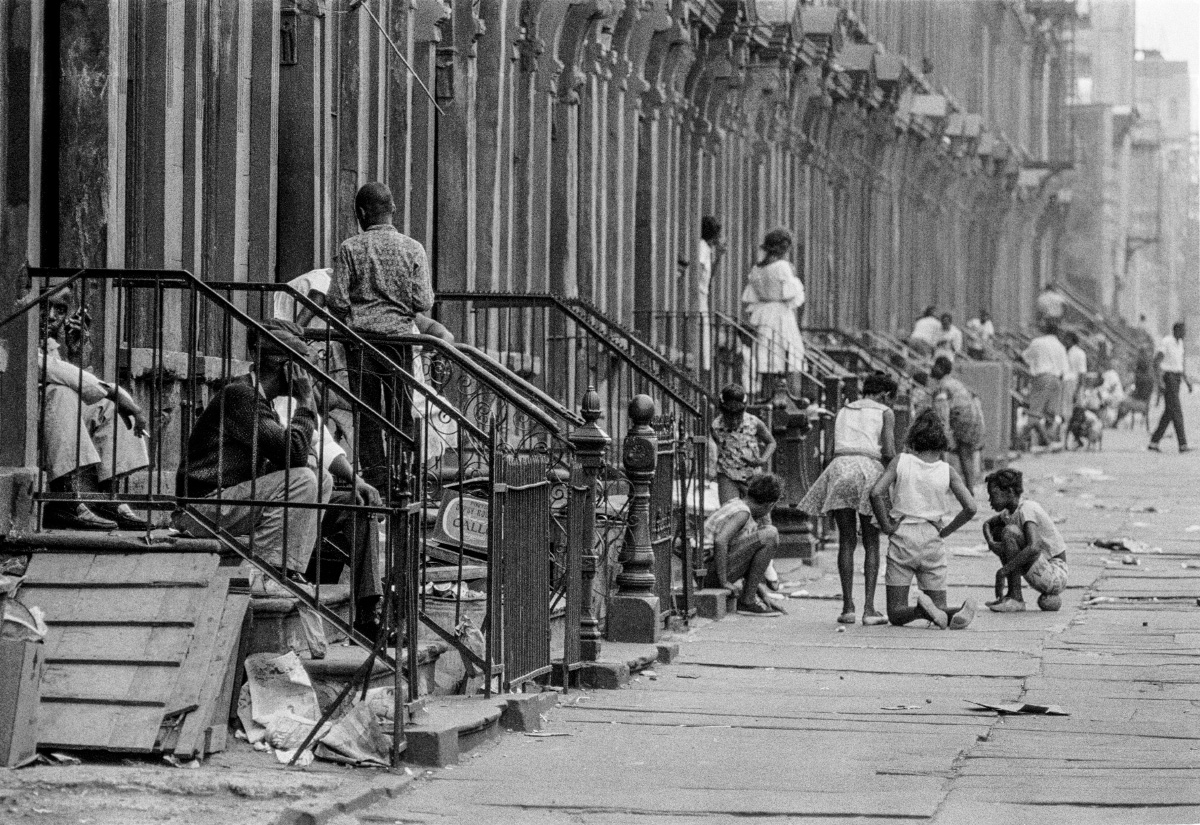Unit
Years: 1964-1967

Freedom & Equal Rights

Historical Events, Movements, and Figures
From 1910-1970, over six million African Americans fled oppression in the South by moving North and West in the Great Migration. Vibrant Black communities boomed in cities such as New York City, Detroit, Cleveland, Chicago, Newark, and Los Angeles, among others. However, Black residents of Northern cities faced racial inequality of a different sort. Discriminatory housing policies and high unemployment levels led to high levels of poverty in majority-Black neighborhoods, police brutality against African Americans was commonplace, and major social, political, and economic disparities remained.
While the nonviolent civil rights movement gained momentum in the South, African Americans in urban areas had limited options to fight for change. Civil unrest–including violent protests, rebellions, and riots–broke out across several cities between 1964 and 1967, fueled by simmering frustration and the summer heat. The rebellions were incredibly destructive; hundreds of people died–mostly African Americans–thousands were arrested, many Black-owned businesses were damaged, and in some cases the National Guard had to intervene.
While several instances of police brutality were the immediate cause of the riots, the U.S. government created a panel called the Kerner Commission to investigate the underlying factors of the unrest and make policy recommendations to avoid future rebellions. The Kerner Report identified that “White racism is essentially responsible for the explosive mixture which has been accumulating in our cities since the end of World War II.”. It further went on to suggest that the government pass reforms in education, healthcare, and employment to address racial inequality in American cities. Dr. Martin Luther King, Jr. said: “A riot is the language of the unheard. And what is it that America has failed to hear?” In this unit of study, you will attempt to answer this very question, and you will consider if the Kerner Commission’s findings are still relevant today.
Student Handout:



Statement on the Riots in Watts by President Lyndon B. Johnson, August 20, 1965
If there is one thing I think we have learned from the civil rights struggle, it is that the problem of bringing the Negro American into an equal role in our society is more complex, and is more urgent, and is much more critical than any of us have ever known. Who of you could have predicted 10 years ago, that in this last, sweltering, August week thousands upon thousands of disenfranchised Negro men and women would suddenly take part in self government, and that thousands more in that same week would strike out in an unparalleled act of violence in this Nations.
Our conscience cries out against the hatred that we heard last week. It bore no relation to the orderly struggle for civil rights that has ennobled the last decade. Every leader in that struggle has condemned this outrage against the laws of the land. And during the few days that preceded it, I had spent all week at the White House visiting individually with Dr. King, Mr. Farmer, Dr. Roy Wilkins, Mr. Philip Randolph—all talking about the great meeting that we had to have here later in the fall, because the cities of this Nation and the Negro family in this Nation are two of our most pressing, most important problems. Well, the bitter years that preceded the riots, the death of hope where hope existed, their sense of failure to change the conditions of life—these things no doubt led to these riots. But they did not justify them.
I hope that every American who believes in equal opportunity for his fellow men, understands this distinction that I have made. For we shall never achieve a free and prosperous and hopeful society until we have suppressed the fires of hate and we have turned aside from violence—whether that violence comes from the nightriders of the Klan, or the snipers and the looters in the Watts district Neither old wrongs nor new fears can ever justify arson or murder....
With . . . rights comes responsibility.
And with responsibility there goes obligation.
We cannot, and we must not, in one breath demand laws to protect the rights of all of our citizens, and then turn our back, or wink, or in the next breath allow laws to be broken that protect the safety of our citizens. There just must never come the hour in this Republic when any citizen, whoever he is, can ever ignore the law or break the law with impunity.
And so long as I am your President I intend to preserve the rights of all of our citizens, and I intend to enforce the laws that protect all of our citizens— without regard to race, religion, region, or without fear or favor.
A rioter with a Molotov cocktail in his hands is not fighting for civil rights any more than a Klansman with a sheet on his back and a mask on his face. They are both more or less what the law declares them: lawbreakers, destroyers of constitutional rights and liberties, and ultimately destroyers of a free America. They must be exposed and they must be dealt with.
It is our duty—and it is our desire—to open our hearts to humanity's cry for help. It is our obligation to seek to understand what could lie beneath the flames b that scarred that great city. So let us equip the poor and the oppressed—let us equip them for the long march to dignity and to wellbeing. But let us never confuse the need for decent work and fair treatment with an excuse to destroy and to uproot.
Ours is an open society. The world is always witness to whatever we do—sometimes, I think (results of the cooperation of some of my friends) to some things we don't do. We would not have it otherwise. For the brave story of the Negro American is related to the struggle of men on every continent for their rights as sons of God. It is a compound of brilliant promises and stunning reverses. Sometimes, as in the past week
when the two are mixed on the same pages of our newspapers and television screens, e result is baffling to all the world. And is baffling to me, and to you, and to us. .nd always there is the danger that hours of disorder may erase the accumulated goodwill of many months and many years. And warn and plead with all thinking Americans to contemplate this for a due period.
Yet beneath the discord we hear another theme. That theme speaks of a day when Americans of every color, and every creed, and every religion, and every region, and every sex can be trained for decent employment, can find it, can secure it, can have it preserved, and can support their families in an enriching and a rewarding environment....
Source: “On the 1965 Watts Riots” Johnson, Lyndon. 1965
www.multied.com/documents/LBJwatts.html
Document 5.22.3

Statement on the Riots in Watts by President Lyndon B. Johnson, August 20, 1965
If there is one thing I think we have learned from the civil rights struggle, it is that the problem of bringing the Negro American into an equal role in our society is more complex, and is more urgent, and is much more critical than any of us have ever known. Who of you could have predicted 10 years ago, that in this last, sweltering, August week thousands upon thousands of disenfranchised Negro men and women would suddenly take part in self government, and that thousands more in that same week would strike out in an unparalleled act of violence in this Nations.
Our conscience cries out against the hatred that we heard last week. It bore no relation to the orderly struggle for civil rights that has ennobled the last decade. Every leader in that struggle has condemned this outrage against the laws of the land. And during the few days that preceded it, I had spent all week at the White House visiting individually with Dr. King, Mr. Farmer, Dr. Roy Wilkins, Mr. Philip Randolph—all talking about the great meeting that we had to have here later in the fall, because the cities of this Nation and the Negro family in this Nation are two of our most pressing, most important problems. Well, the bitter years that preceded the riots, the death of hope where hope existed, their sense of failure to change the conditions of life—these things no doubt led to these riots. But they did not justify them.
I hope that every American who believes in equal opportunity for his fellow men, understands this distinction that I have made. For we shall never achieve a free and prosperous and hopeful society until we have suppressed the fires of hate and we have turned aside from violence—whether that violence comes from the nightriders of the Klan, or the snipers and the looters in the Watts district Neither old wrongs nor new fears can ever justify arson or murder....
With . . . rights comes responsibility.
And with responsibility there goes obligation.
We cannot, and we must not, in one breath demand laws to protect the rights of all of our citizens, and then turn our back, or wink, or in the next breath allow laws to be broken that protect the safety of our citizens. There just must never come the hour in this Republic when any citizen, whoever he is, can ever ignore the law or break the law with impunity.
And so long as I am your President I intend to preserve the rights of all of our citizens, and I intend to enforce the laws that protect all of our citizens— without regard to race, religion, region, or without fear or favor.
A rioter with a Molotov cocktail in his hands is not fighting for civil rights any more than a Klansman with a sheet on his back and a mask on his face. They are both more or less what the law declares them: lawbreakers, destroyers of constitutional rights and liberties, and ultimately destroyers of a free America. They must be exposed and they must be dealt with.
It is our duty—and it is our desire—to open our hearts to humanity's cry for help. It is our obligation to seek to understand what could lie beneath the flames b that scarred that great city. So let us equip the poor and the oppressed—let us equip them for the long march to dignity and to wellbeing. But let us never confuse the need for decent work and fair treatment with an excuse to destroy and to uproot.
Ours is an open society. The world is always witness to whatever we do—sometimes, I think (results of the cooperation of some of my friends) to some things we don't do. We would not have it otherwise. For the brave story of the Negro American is related to the struggle of men on every continent for their rights as sons of God. It is a compound of brilliant promises and stunning reverses. Sometimes, as in the past week
when the two are mixed on the same pages of our newspapers and television screens, e result is baffling to all the world. And is baffling to me, and to you, and to us. .nd always there is the danger that hours of disorder may erase the accumulated goodwill of many months and many years. And warn and plead with all thinking Americans to contemplate this for a due period.
Yet beneath the discord we hear another theme. That theme speaks of a day when Americans of every color, and every creed, and every religion, and every region, and every sex can be trained for decent employment, can find it, can secure it, can have it preserved, and can support their families in an enriching and a rewarding environment....
Source: “On the 1965 Watts Riots” Johnson, Lyndon. 1965
www.multied.com/documents/LBJwatts.html
Document 5.22.3
A mass movement of African Americans from the rural Southern United States to the urban North and Midwest between the early 20th century and the 1970s, driven by factors such as racial segregation, economic opportunities, and the promise of a better life in Northern cities.
White flight refers to the phenomenon in which white residents, typically from urban areas, move away from racially diverse neighborhoods or cities to suburban or predominantly white areas. It often occurs in response to changes in demographics, social tensions, or perceived threats.
The discriminatory practice of denying or limiting financial services, such as loans or insurance, to certain geographic areas, often based on the racial or ethnic composition of those areas, contributing to racial segregation and disparities in housing and credit.
A social and political movement in the United States during the mid-20th century, characterized by nonviolent protest, civil disobedience, and grassroots organizing, aimed at ending racial segregation and discrimination, securing civil rights and voting rights for African Americans, and challenging systemic racism and injustice in American society. Led by figures such as Martin Luther King Jr., Rosa Parks, and John Lewis, the nonviolent civil rights movement played a key role in advancing racial equality and social change.
A social and political movement of the 1960s and 1970s advocating for racial pride, self-determination, and liberation for African Americans, often through direct action, community organizing, and cultural expression.
A political and social movement advocating for the empowerment, self-determination, and liberation of African Americans, often through the promotion of black pride, unity, and separatism.
A state of public disorder, rioting, or protest characterized by violence, lawlessness, or disruption of the social order.
A landmark report issued by the National Advisory Commission on Civil Disorders in 1968, also known as the Kerner Commission, which investigated the causes of racial unrest and urban uprisings in the United States and called for comprehensive reforms to address poverty, discrimination, and inequality in American society.